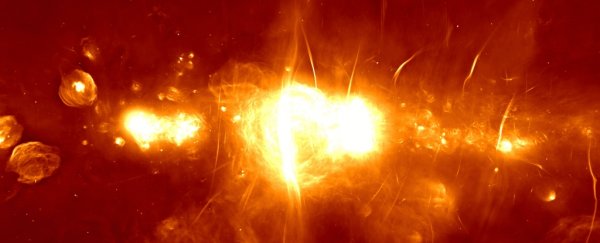For a while, astronomers were puzzled by the extraordinary abundance of three metals seen in the heart of our galaxy. As it turns out, the whole thing was simply an illusion, new research has found.
Earlier this year, researchers released a paper with a really bizarre finding. After examining the spectra of red giant stars close to the centre of the Milky Way, less than three light-years from the supermassive black hole Sagittarius A*, they found a curious abundance of three metals, scandium, vanadium, and yttrium.
How did it get there? After all, scandium and vanadium are mainly products of Type II and Type Ia supernovae, respectively, while yttrium comes from asymptotic giant branch stars. Could it tell us something new about the formation history of the galactic nucleus?
Well, no. Because according to a new international team of astronomers, the spectral lines that seemed to indicate the presence of these elements actually did no such thing. And it all has to do with the stars' temperature.
"These giant red stars have used up most of their hydrogen fuel and their temperatures are therefore only half of the Sun's," said astronomer Brian Thorsbro of Lund University in Sweden.
The spectral line that indicates scandium changes according to temperature, so the team figured out that electrons in stars at temperatures lower than around 3,800 Kelvin, behave differently than those in higher temperature stars.
Using the W. M. Keck Observatory on Mauna Kea, Hawaii, the research team studied two M-type giants that were the subject of the earlier study, as well as a number of M giants in the solar neighbourhood, far from the galactic nucleus.
They found that the strong scandium - and yttrium and vanadium - lines were a feature of all the M-type giant stars they studied, not just those around the centre of the galaxy.
Even if they are real spectral signatures, therefore, they can't tell us anything about the galactic nucleus specifically.
But those M stars in the solar neighbourhood the researchers used for comparison? The scandium abundances in those are known. And they are not unusually high.
So it seems more likely that the spectral lines are liars.
"We conclude that the Sc I lines in cool stars are strong everywhere in the galaxy and is an inherent property of the line formation process, and should not be used to derive the scandium abundance of the stars," the researchers wrote in their paper.
As for how the lines are formed, that still needs a bit of work. The team argue that there are "several physical reasons" for a strong spectral line to appear; teasing out what causes scandium lines to appear in cool stars needs to be investigated further.
"The strong lines are a property of the line formation process that currently escapes accurate theoretical modelling," the researchers wrote.
"We further conclude that for giant stars with effective temperatures below approximately 3800 K these Sc I lines should not be used for deriving the scandium abundances in any astrophysical environment until we better understand how these lines are formed."
The team's paper has been published in The Astrophysical Journal.
